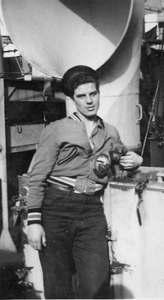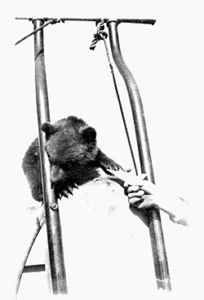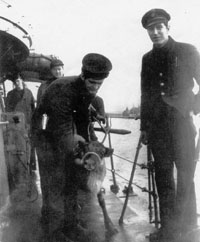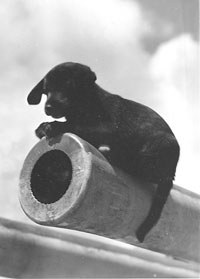Since the early days of sail, creatures furry and feathered have featured as mascots and companions in the shipboard lives of sailors. Often, the most important role of animals at sea was to provide comfort and a sense of home, especially in times of war:
“In the Navy, and particularly in the sea-going ships of the Service, mascots are one of the chief ‘builder-uppers’ for the sailors.
The playful puppy that scampers about decks and trembles fearfully under a bunk when guns begin to bang, reminds men of that puppy they left at home. It gives them something on which they can shower affection without fear of being laughed at, for even the toughest of sailors will be gentle and kind with an animal.” — From the photo feature Mascots for Morale in the June 1945 issue of The Crow’s Nest, the Canadian Navy newspaper.
Some animal companions took warfare at sea completely in stride, as historian Dr. Gilbert Tucker recalls in his account of U-210’s battle with HMCS ASSINIBOINE in the Atlantic fog. Tucker witnessed the U-boat’s sinking from the destroyer’s bridge, and considered the victory “a masterpiece of tactical skill”. Dr Tucker also observed:
“The ship’s dog, a compound puppy, who was accustomed to lie down, looking like a poached egg, in the very spot where some heavy man was about to tread, lay at its moorings throughout the tumult with every hair in place. The captains’s cat, being a cat, found a comfortable hide-out within the vitals of the ship.”
Pet animals are no longer permitted aboard Canadian naval vessels. But over the years, Canadian sailors have kept a menagerie of creatures with them at sea, including –
- a rabbit (HMCS HAIDA);
- a monkey (HMCS RESTIGOUCHE):
- Gertrude and Gus, both geese (HMCS HEPATICA, HMCS LANARK):
- Percy the groundhog – find his story in James B. Lamb’s book The Corvette Navy;
- a northern saw-whet owl that hitched a ride while the ship was on its way to Norfolk, Virginia (HMCS PRESERVER).
As a joke, sailors from HMCS NADEN kept a goat for a mascot; the goat was supposed to help with grounds-keeping around the Base. Sailors also adopted a wide variety of other animals.
When the crew of HMCS THIEPVAL returned to Esquimalt from the northern island of Hokkaido, Japan in 1924, they brought with them a living reminder of their travels, a higuma (brown bear).
Signalman Tim Ryley of HMS (later HMCS) SHEARWATER purchased a parrot at as a pet while at Corinto, Nicaragua.
Some animals have ended up aboard Canadian ships more or less as passengers, including a pair of lion cubs.
One of Canada’s most famous wartime vessels, HMCS HAIDA, transported a reindeer to the Admiral Commanding Orkneys and Shetlands during the WWII Battle of the Atlantic convoys. It was taken as a goodwill gift from a Russian Admiral. Former HAIDA crew member George Mannix wrote about the reindeer in his memoirs:
“…We got the reindeer, along with a large bag of lichen and moss for feed en route. A likely looking prairie lad was selected to become herd master and we put to sea. On the second day, [it was] discovered that our herd master was feeding the animal by the armful as if it was a cow. In a very few days we were out of feed and no chance of getting any more. Various sailors gave up their rations so the beast would not starve to death. “
Sailors from Phoenicia are thought to have brought the first domesticated cats to Europe aboard their ships around 900 BC. Cats play an important role in making life aboard ship clean and safe by catching mice, rats, and other pests. Rats and mice can badly damage woodwork and ropes. If not stopped, they can also eat all the food being carried to feed the crew, and bring disease aboard, a major worry when ships were at sea for long periods of time. Because cats adapt well to new surroundings, they are suited to shipboard life.
Unlike cats, which have a job to do aboard ship, the role of ships’ dogs is less defined. Dogs on ships can be helpful in recovering items that have fallen overboard, and fishermen have found them useful for retrieving fish and even swimming from ship to shore with hawser lines. Practicalities aside, the most important function of most ships’ dogs was probably companionship.
Admiral Bill Hughes, former Executive Officer of HMCS TERRA NOVA, fondly recalls the origins of his ship’s mascot, Percy the Penguin:
“As soon as I saw that TERRA NOVA had a penguin in the ship’s badge, my wife and I went on a hunt. We were walking down the street in Port Alberni one day when we spotted a stuffed penguin in a shop window. We bought it and my wife made him the uniform of a sub-lieutenant.
He experienced many adventures over the next two years, including flying from Bermuda to New York with an airline stewardess, appearing on stage with the Bluebell Girls at the Alhambra Theatre in Glasgow, Scotland, getting kidnapped in Panama and so forth….
Under our articles page Good Companions, see more stories of ships’ mascots and those who befriended them, featuring Percy the groundhog, Alice the media superstar dog of HMCS CAYUGA, and Tim Ryley’s noisy but amusing parrot.
By Clare Sharpe
Museum Exhibit Designer/webmaster




 CFB Esquimalt Naval and Military Museum
CFB Esquimalt Naval and Military Museum CFB Esquimalt Naval and Military Museum
CFB Esquimalt Naval and Military Museum CFB Esquimalt Naval and Military Museum
CFB Esquimalt Naval and Military Museum CFB Esquimalt Naval and Military Museum
CFB Esquimalt Naval and Military Museum CFB Esquimalt Naval and Military Museum
CFB Esquimalt Naval and Military Museum CFB Esquimalt Naval and Military Museum
CFB Esquimalt Naval and Military Museum CFB Esquimalt Naval and Military Museum
CFB Esquimalt Naval and Military Museum CFB Esquimalt Naval and Military Museum
CFB Esquimalt Naval and Military Museum CFB Esquimalt Naval and Military Museum
CFB Esquimalt Naval and Military Museum CFB Esquimalt Naval and Military Museum
CFB Esquimalt Naval and Military Museum CFB Esquimalt Naval and Military Museum
CFB Esquimalt Naval and Military Museum CFB Esquimalt Naval and Military Museum
CFB Esquimalt Naval and Military Museum CFB Esquimalt Naval and Military Museum
CFB Esquimalt Naval and Military Museum CFB Esquimalt Naval and Military Museum
CFB Esquimalt Naval and Military Museum CFB Esquimalt Naval and Military Museum
CFB Esquimalt Naval and Military Museum CFB Esquimalt Naval and Military Museum
CFB Esquimalt Naval and Military Museum CFB Esquimalt Naval and Military Museum
CFB Esquimalt Naval and Military Museum